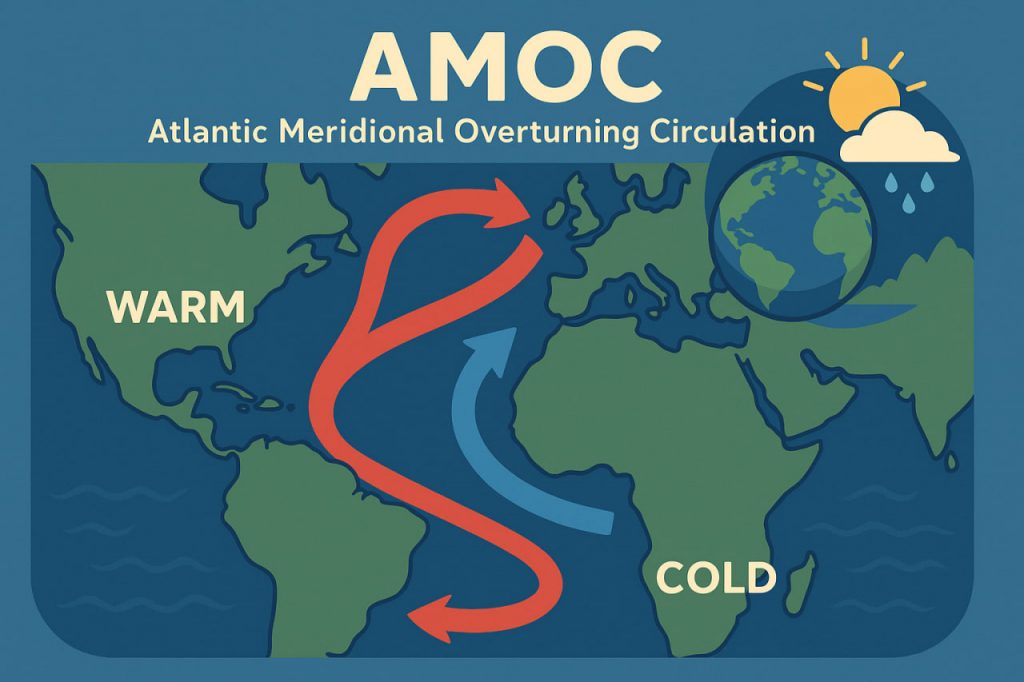Beneath the surface of the Atlantic Ocean flows one of the most important systems regulating our planet’s climate — the Atlantic Meridional Overturning Circulation, or AMOC. Often called the “great ocean conveyor belt,” this powerful current carries vast amounts of heat across the globe, connecting polar regions with the tropics. Yet, in recent decades, scientists have warned that this system is weakening — and its potential collapse could trigger a chain of dramatic and irreversible climate shifts.
What Is AMOC?
The Atlantic Meridional Overturning Circulation (AMOC) is a large-scale system of ocean currents that move warm, salty water northward from the tropics toward the North Atlantic, where it cools, sinks, and returns southward at deeper levels.
This process acts like a global heat engine, distributing energy around the planet and stabilizing the climate.
Key components of AMOC include:
- The Gulf Stream, which carries warm water along the east coast of North America.
- The North Atlantic Drift, extending that warmth to Western Europe.
- The Deep Water Formation Zone, near Greenland and Iceland, where cooled, dense water sinks to the ocean depths.
Without AMOC, regional climates — especially in Europe — would be drastically different, with colder winters and disrupted weather patterns.
How AMOC Regulates Global Climate
AMOC is vital for maintaining the delicate balance of global temperatures.
- It warms Northern Europe, making cities like London or Oslo far milder than other regions at the same latitude.
- It helps regulate monsoons in Africa and South America.
- It influences carbon storage in the deep ocean, affecting greenhouse gas levels in the atmosphere.
- It drives nutrient circulation, supporting marine ecosystems and fisheries.
Essentially, AMOC functions as the bloodstream of Earth’s climate system — transporting heat, nutrients, and carbon across the planet.
Why Scientists Are Concerned
Recent research shows that AMOC has slowed by about 15–20% since the mid-20th century, possibly reaching its weakest state in more than a thousand years.
The main cause? Melting ice from Greenland and Arctic regions, which adds vast amounts of cold, fresh water to the North Atlantic. This lighter water dilutes the salt concentration and prevents the dense sinking motion that drives the circulation.
If this process continues, it could trigger a tipping point — where the system collapses entirely or shifts into a new, weaker state.
Potential Consequences of AMOC Collapse
The failure of the AMOC would have global consequences. Scientists predict several catastrophic outcomes:
- Cooling in Northern Europe: Average temperatures could drop by up to 5–10°C, creating harsh winters and shorter growing seasons.
- Sea Level Rise: Water accumulation along the U.S. East Coast could increase sea levels by up to 50 cm.
- Disrupted Monsoons: Rainfall patterns in West Africa, India, and South America could shift, causing droughts or floods.
- Marine Ecosystem Collapse: Altered ocean circulation could reduce oxygen levels, threatening fisheries.
- Accelerated Warming in the Southern Hemisphere: As heat builds up elsewhere, other regions may experience extreme temperature spikes.
These changes could unfold within decades if current trends continue.
Early Warning Signs
Scientists monitor AMOC using ocean buoys, satellites, and temperature salinity profiles. Warning indicators include:
- Declining sea surface salinity in the North Atlantic.
- Slower Gulf Stream flow.
- Unusual sea level changes along the eastern U.S. coast.
- Disrupted weather patterns in Europe and the Arctic.
One alarming study published in Nature Climate Change (2021) suggested that AMOC may be approaching a critical transition point, beyond which recovery is impossible on human timescales.
Can It Be Prevented?
The only effective way to stabilize AMOC is by slowing global warming and reducing ice melt. Key steps include:
- Rapidly cutting CO₂ and methane emissions.
- Protecting polar ice and limiting Arctic industrial activity.
- Restoring forests and wetlands that absorb carbon.
- Enhancing ocean monitoring systems to detect early instability.
If humanity succeeds in keeping global temperature rise below 1.5°C, the AMOC might remain stable. Exceeding that threshold, however, could make collapse inevitable.
Interesting Facts
- The AMOC transports around 20 million cubic meters of water per second — about 100 times the flow of all the world’s rivers combined.
- Without AMOC, Europe’s climate would resemble parts of northern Canada.
- The last major AMOC shutdown occurred about 12,800 years ago, triggering a mini ice age known as the Younger Dryas.
- Oceanographers measure AMOC strength in Sverdrups (Sv) — one Sv equals one million cubic meters per second.
- Even a 10% slowdown can alter weather patterns across the entire Northern Hemisphere.
Glossary
- AMOC (Atlantic Meridional Overturning Circulation) — a major system of ocean currents that regulate global heat distribution.
- Thermohaline circulation — ocean movement driven by differences in temperature (thermo) and salinity (haline).
- Tipping point — a threshold after which a system changes irreversibly.
- Albedo effect — the reflection of sunlight by ice or snow; its loss accelerates warming.
- Younger Dryas — a sudden cooling event about 12,800 years ago linked to AMOC disruption.


